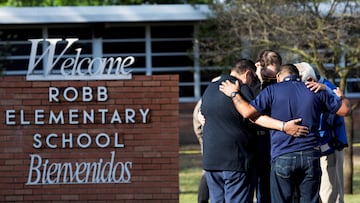More children have died in school shootings in 2022 than police officers in the line of duty: fact check
Have more children been killed at school than police officers on duty? Do teachers want to be armed? We took a look at these claims.

As the nation grapples with the deadliest mass shooting involving young children since the attack on Sandy Hook Elementary school in 2012, a few misleading claims circulating online should be addressed.
Claim #1: More students have died from gunshot wounds at school that police officers in the line of duty.
This claim is true. The Officer Down Memorial Page has recorded twenty deaths by gunshot in the line of duty this year. As of 25 May, twenty-four children or teenagers have been killed by guns on school sites across the United States, according to Education Week.
Claim #2: The United States has experienced 288 school shootings this year
This claim is false.
The claim comes from the website World Population Review, which published a graphic that ranks countries by the number of school shootings that have occurred. The graphic, which reports 288 mass shootings at schools in 2022 in the US, is based on a 2018 article published by CNN that looked at the number of school shootings that had occured between 2009 and 2018.
Everytown USA, a gun safety advocacy organization, has reported seventy-seven shootings on school campuses between 1 January to 17 May. Typically law enforcement classify an event as a mass shooting if there are at least four casualties or injuries. This year, there have only been two other incidents, aside from that at Robb Elementary, where more than four people were shot.
The first took place in Milwaukee, Wisconsin, in February. Five women were injured after “a fight broke out between two teenager girls in the school parking lot after a basketball game [...]. One of the girls called her uncle, who shot his gun at the ground,” wounding a fifteen, sixteen, seventeen, and twenty-year-old women.
The second took place in Washington DC in April, with Everytown describing the event by saying that a “23-year-old male lone wolf fired more than 200 bullets from his apartment window, aimed at the school.” No one was killed by four people wounded, including a “12-year-old student, two women in vehicles, and a school security guard.”
While neither of these incidents involved a fatality, there have been fifteen cases where guns were fired on school grounds that did end with at least one death.
Claim #3: A good guy with a gun can stop a bad guy with a gun
The fact that more children have died by gunfire at schools than police have in the line of duty is quite jarring for most people. Many, including responsible gun owners, see this as too high a price to pay for the right to bear arms.
Additionally, as many Republicans call for a more significant presence of law enforcement and guns on school grounds, it begs the question of whether this is an effective way to protect both children and law enforcement officers.
Earlier this month, when a white nationalist killed ten patrons at a grocery store in Buffalo the store security guard, a retired police officer, Aaron Salter, was one of the people killed. Salter was one of the first people to engage the shooter, firing multiple shots that did not affect the attacker because of his tactical gear.
Similarly, at Robb Elementary School, two police officers were able to engage the shooter before he entered the campus. The two officers reportedly exchanged fire with the gunman but were were unable to stop him and waited for backup to enter the school, giving him time to murder twenty-one people, nineteen of which were children.
What both the case of the two responding officers in Texas and Aaron Salter highlight is the danger current gun laws pose for law enforcement officials. Not only do they leave children and the general public, vulnerable to violence, but the law enforcement officers themselves.
Do teachers want to be armed?
Aside from police officers, some Republican lawmakers also support the idea of arming teachers. The problem is many teachers do not want to be armed, and they are not interested in having a firearm in their classroom.
A 2019 study conducted by California State Univerity at Northridge found that “the overwhelming majority [95.3 percent] do not believe teachers should be carrying a gun in the classroom.” Another concern for many was having to use the weapon, with under 6.5 percent saying they would be comfortable using the weapon in a case a shooter entered the school.
When looking at those who were gun owners, only 11.5 percent said that they “believed being armed while teaching should be part of a teacher’s responsibilities.”
Lastly, the researcher reported that a majority, sixty-four percent believed that the presence of firearms on campus could pose a greater threat to school saftey.






